I'm a huge fan of food magazine Bon Appetit. I love the brand's voice, messaging, and content, so when I found the corresponding YouTube channel for the publication last year, I was immediately sold.
When you dive into Bon Appetit's YouTube channel, you'll find a cast of chefs. They either host their own show, make a recipe video, or both. For instance, my favorite Bon Appetit chef, Carla Lalli Music, hosts "Back to Back Chef" on the channel, but also has a few recipe videos.
Recently, I went to browse the official website to purchase merchandise. (Hey, I have to represent my favorites!) What I found, in addition to the merchandise, was one of Music's recipe videos for ragu, using a specific brand of sauce from Barilla:
"So, cool," I thought to myself. "Even though this is an advertorial, I love the content, so I'll keep watching."
An advertorial is, like the name suggests, an advertisement. But they are unique in their own way. Let's define what an advertorial is, and how it can be an excellent marketing choice for you and your team.
A good advertorial doesn't clearly state that an advertiser made the post in the copy, but it also doesn't hide that fact. An advertorial should provide the same high-quality content as a blog post or video, but give a spotlight to the product being advertised.
For example, let's say I'm on the marketing team for a company that offers social media services, and I'm in charge of writing an advertorial. I might write a listicle that talks about the top social media tools in the marketing industry, and include my company's software somewhere in the list.
This approach accomplishes promoting my company's services, but also provides valuable information to readers about other tools, like an editorial piece. Advertorials can be used as a valuable marketing technique for visibility and conversion, so let's explore that, next.
Benefits of Advertorial Marketing
When you use an advertorial, you're using a marketing technique that's often used for brand exposure, conversion, and lead generation. In this section, we're going to talk about how.
1. You can convert leads.
First, if you have blog post ideas that relate to your industry, you might consider sourcing out a publication that is interested in advertorials for your industry. For instance, if you run an ecommerce technology business, a publication like The New Yorker might not be a viable option — instead, you might want to consider a publication like TechCrunch, which specializes in all things technology and commerce.
Your advertorial would be shown to audiences that are the most interested in your industry, so you can increase exposure to the right audiences. You might be able to convert quite a few leads from this method.
2. Advertorials build brand awareness.
Next, let's say you want to build brand awareness with paid ads, but are looking to advance your efforts past social media or TV ads. An advertorial might be a good alternative. The post, unlike ads, is paid for less often, but has the potential to be found by readers long after the publish date.
For instance, let's say you pay for an advertorial tomorrow. Generally, you won't have to keep paying to boost the visibility of your ad, like you would have to with other ads. You can earn organic traffic continuously with an advertorial.
3. Retarget your existing customers.
Lastly, if you're thinking about advertorial marketing, think about how you can retarget your advertorial on your end. When the advertorial is posted, how can you fit it into your content plan to provide value to your existing customers?
Maybe your advertorial is a filmed interview with an industry thought leader, and your customers respond really well to video. You can post the advertorial on your social media accounts, and boost the fact that you partnered with a publication to bring a new video to your audience.
Similarly, you can embed the advertorial into your email list. Your email subscribers are likely devoted customers, so sharing the post with that audience is most likely going to earn you some traffic.
Encouraging your customers to share the post on social media and tag your company is a great way to increase brand awareness online, promote your advertorial, and gain user-generated content from your audience. User-generated content is a fantastic content idea that gives a voice to satisfied customers to market your product from their point of view.
Does all of this sound like an opportunity that can't be missed? If your answer is, "Of course!", you're probably wondering what goes into an advertorial to make them stunning. So, let's talk about writing an advertorial, next.
Advertorial vs. Editorial
Including company software among a listicle is just one of the ways to write a successful advertorial. Just like there are multiple ways to market products, there's multiple ways to create an advertorial.
Ultimately, how you structure your advertorial is dependent on the brand voices of your company and the publication for which you're writing.
If your brand voice is more formal, but you're writing for a publication like BuzzFeed, which is known for its less-formal tone, blend the two harmoniously so your advertorial can speak to both audiences. (Alternatively, perhaps your target audience for this campaign supports a change of tone, which is 100% okay).
To make sure you write an effective advertorial that doesn't sound too much like a blog post or too much like an ad, we're going to analyze what makes editorial content, like a blog post or product page, vs. what makes an advertorial. These tips will help guide your writing process.
1. Write for value, not to promote.
Your advertorial should include valuable copy. You don't need to write a blatant ad for your product or company. Instead, advertorials should take the tone of a blog post.
Blog posts are meant to provide information that audiences can find value from. So, when you sit down to create the concept of your advertorial, think about how you can serve your target audience with educational content, first.
Maybe your campaign goal is to increase visibility of your new product. If that's the case, think of writing a listicle that mentions competitive products and include yours at the top. This provides valuable information to audiences you're interested in, as well as the other way around.
2. Stick to what your title says.
When your advertorial pitch gets accepted by a publication, or after you've written a draft, read it for continuity: Does your advertorial accomplish what you said it would in the title?
For instance, if your post title is, "Marketing Tips for a Team of One," but you spend the advertorial talking about how wonderful your marketing agency is at building brand awareness, your post is going to sound more like a product page.
It's important you align the information in your article with your title, so readers know what they're getting into when they read the title of your advertorial. Additionally, you won't lose credibility for false advertising, and you can be sure you're serving your audience.
3. Solve for the customer.
Serving audiences should be one of your top priorities with an advertorial. Yes, advertorials help your company out, but ultimately, solving for the customer generates new ones.
Advertorials aren't a chance for you to shout out how your company solves all of the challenges presented in your advertorial. Instead, this is a chance for you to reach a new audience with high-quality content.
If you want to place an ad for your company in tandem with an advertorial, discuss the possibility with the publisher. You may be able to purchase ad space that will separate the purposes of your content.
4. Inspire action.
Remember, your advertorial should still be some sort of an advertisement, even if it's not as visible as others. And, with all ads, you should inspire action by the end of the post.
Instead of including a huge, shiny CTA button that looks amazing on your product pages, weave action into the narrative of your advertorial. For example, if you are going to write one about your latest data report, include a link to read it, or a screenshot of a compelling part of the report that links to the content offer for it.
Similarly, you can make an interactive advertorial, like a quiz, that tests your readers' knowledge about the subject, then provide a resource where they can learn more about the subject by accessing one of your offers.
5. Avoid only talking about your company.
This is a huge rule of thumb. To ensure your advertorial doesn't take the form of a long-form ad, avoid only talking about your company in the advertorial.
It's common to think that this point only applies to listicles, but it's something to think about regardless of the type of advertorial you're writing. Even if your content includes a quiz, you can have a couple of the questions mention competitors, and how they fit into the lives of your customers.
Similarly, if you're writing a "How-to" guide, when you include your company as a resource, be sure to mention another option or two. To diversify your content, add value to the reader, and show your knowledge of the industry, mentioning other brands in the post is key.
6. Delight your readers with exceptional content.
If you're writing an advertorial, it's a good chance to try something new to delight your customers — for instance, maybe include animations instead of photos, emojis instead of text, or even a different style of writing that's different from your typical brand voice.
The chance to participate in something new will engage with those leads. If you're writing for the needs of your audience, you want them to feel like their experience reading your advertorial was a delightful one.
You can also try out some new optimization techniques. Maybe you create a content offer that's specific to a campaign. You can experiment here, and cater to new leads with your piece.
Now that you have some tips about how to create an advertorial, let's go over some examples you can refer to if you get stuck writing, formatting, or finalizing your post.
Advertorial Examples
If you're wondering about the effectiveness of your advertorial, we're going check out these examples to get an idea of how to make one that's incredible.
1. Cole Haan x Forbes
Forbes runs a series on their website called BrandVoice, which is a series dedicated to expert advice from marketers. This BrandVoice in particular is an advertorial from footwear company, Cole Haan, about exploring creativity: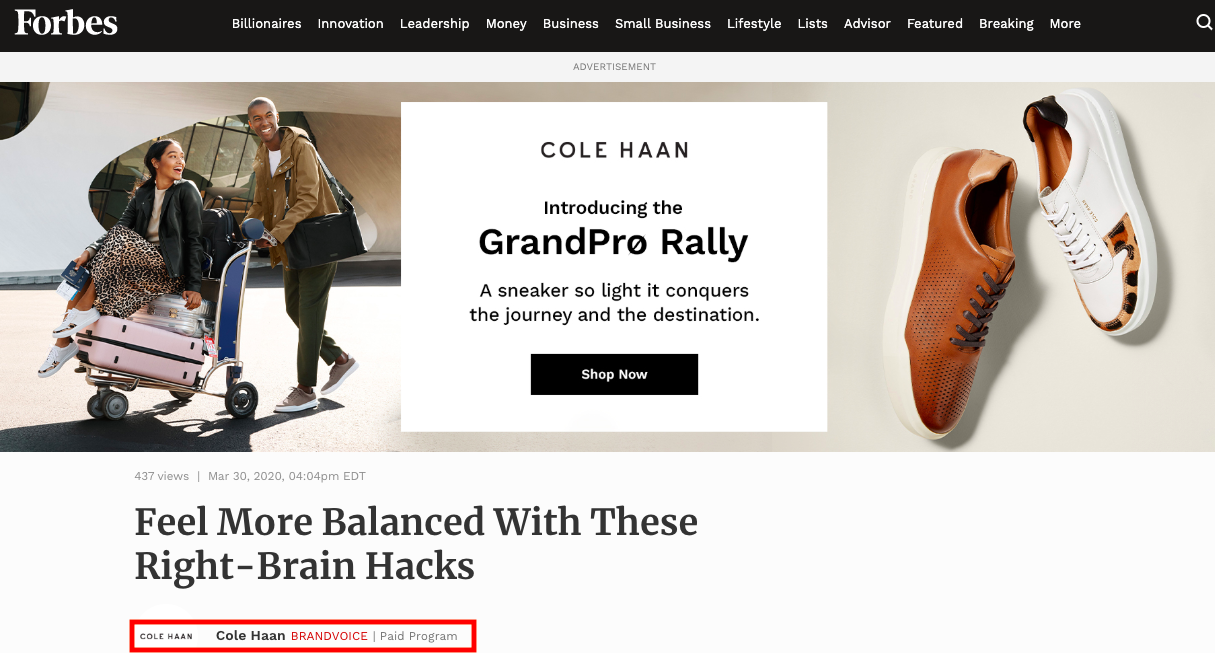
At the top of this post is a banner ad for Cole Haan. Putting this ad at the top of the post, rather than the body, reinforces that the post is an advertisement, but doesn't make the copy suffer for it.This advertorial supports balancing your mind, and moving productively inside your home. While the post itself doesn't mention the words "Cole Haan," or promote the company's products, the content still relates to the concept of moving your feet, which aligns with what the company sells.
If you want your advertorial copy to be a little more low-key, but still include an advertisement for your post somewhere on the webpage, think about adding in a paid ad, similar to Cole Haan's.
2. Sapphire x Thrillist
Sapphire is a credit card rewards card offered by Chase Bank. Cardholders can earn points and rewards based on how much they spend at restaurants using the card. This advertorial gives a spotlight to must-try restaurants, in efforts to get readers thinking about how to use the Sapphire card: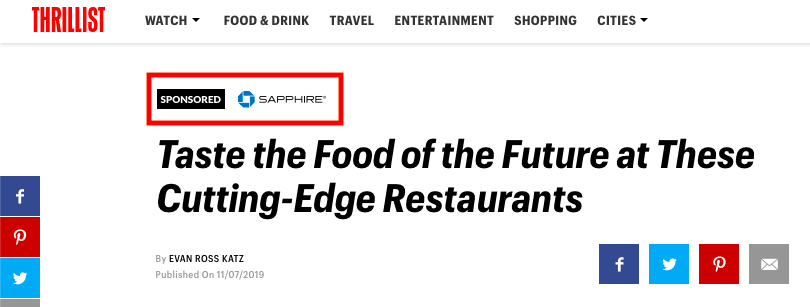
This advertorial shows how a listicle doesn't need to include your product to be successful. Instead, you can write about keywords that reflect your company or industry. As long as the advertorial supports your company in some way, it's still effective.What's great about this advertorial is that it takes an intriguing angle. Diving into restaurants that offer unique and futuristic food is an exciting topic. And, in keeping in line with Thrillist's laid-back, friendly brand voice, the post's language isn't as formal.
3. Captain Morgan x BuzzFeed
Similar to the last example, this advertorial for Captain Morgan, an alcohol company, is a listicle from BuzzFeed Germany (Non-native speakers have the option to translate the page). What's not similar to the last example is that this advertorial mentions the company and its products by name. Even so, this advertorial provides valuable information to the reader, so the advertorial is still effective.
The advertorial's structure and copy make it an engaging, helpful read, even though it mentions the product more than once. It contains drink recipes that you can make at home, along with pictures to use as a guide: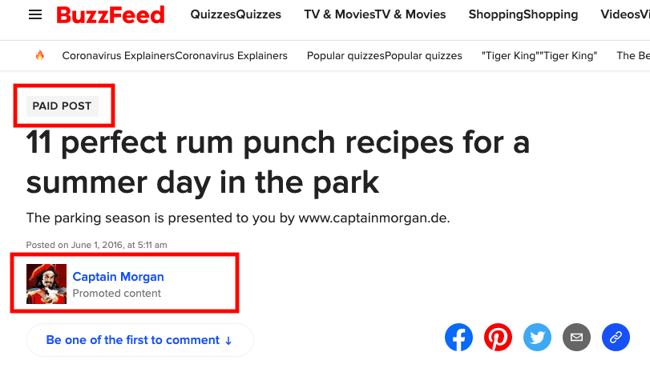
Recipes, along with guided pictures and ingredients, accomplishes two things. First, it gives plenty of ideas for fans of Captain Morgan, who may already have the products mentioned, but need inspiration for what to do with it. A simple Google query like "recipes with Captain Morgan" would bring the fan to this BuzzFeed advertorial.
This post can also catch the eyes of readers who want simple rum recipes to try out and need inspiration. It gives enough recipe variations to spark inspiration, and capitalizes on the seasonality, since this post went up during a summer month.
4. Love Beauty Planet x The New York Times
Sustainability is a big focus for beauty company, Love Beauty Planet. One of the company's values is to produce their products ethically and with recycled materials to reduce their carbon footprint. This emphasis on going green is the focus for the company's advertorial that was featured in The New York Times: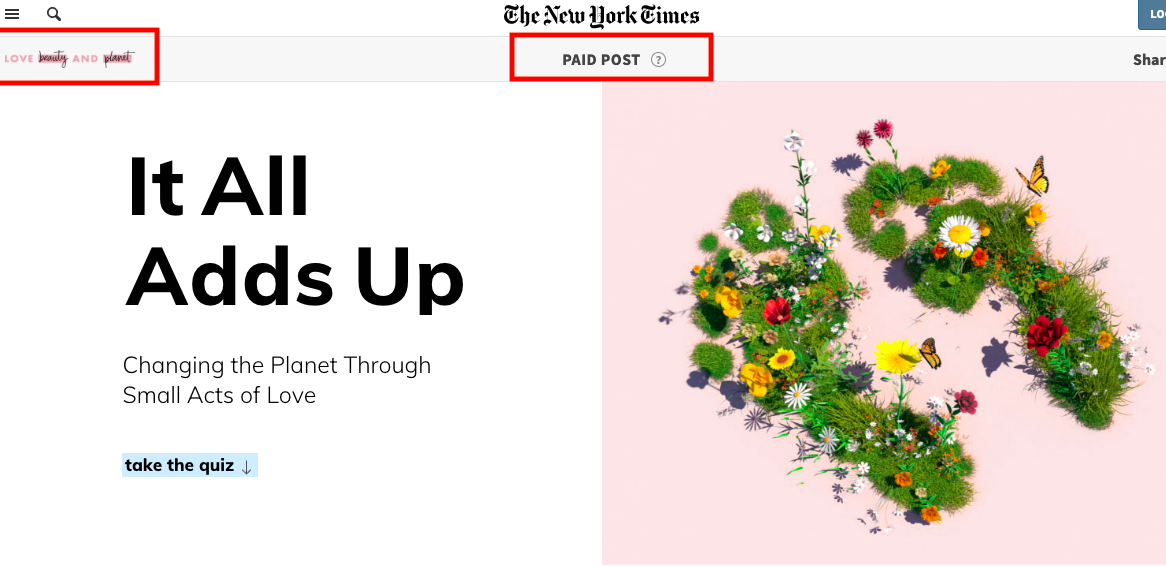
Creating an advertorial that's a little more interactive than a text-only blog post is a strategy you could use to make your advertorial more engaging. If your quiz is shorter, like Love Beauty Planet's, you can provide valuable, actionable takeaways at the end, to keep your brand in the reader's mind as they implement the tips.This editorial is an interactive one, which first quizzes the reader's knowledge of recycling and reducing waste. After answering the five questions, the post shares small things readers can do to reduce their carbon footprint.
5. PwC and RYOT Studio x The Huffington Post
For this advertorial, two companies collaborated to make a paid post that mixed copy with video. PwC and RYOT Studio worked together to produce an entry in PwC's new series for diversity and inclusion for CEOs. The company offers business solutions for customers, so the angle keeps consistent with PwC's industry:

What this advertorial does really well is provide readers with a video to go along with the blog post. The video presents the content really well, so those who don't usually enjoy interacting with long-form content don't have to read as much.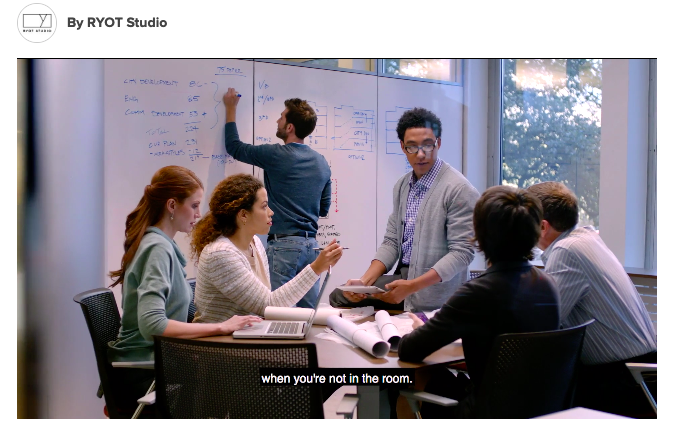
If you have a video that tells the story of your company really well, and want to build some brand awareness, consider submitting it along with a couple of paragraphs of supporting copy for an advertorial. It can expose your company to a new audience, and be awesome for generating leads.
Now, you know how to spot an advertorial and even write one of your own. Advertorials can spice up your content marketing strategy and bring a community of new audience members to your brand, so make sure to put your best foot forward, and good luck!
from Marketing https://ift.tt/2ywPpr8
No comments:
Post a Comment